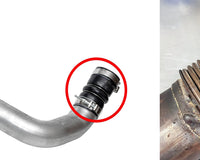The Ford 6.7 Powerstroke is among the most popular and powerful diesel engines on the market. Ford Super Duty owners have come to appreciate not only the power, but also the reliability and durability of the 6.7L Powerstroke. When properly maintained, it is not unusual for the 6.7L Powerstroke engine to be going strong, even after several hundred thousand miles.
Oil level and quality are critical for the Powerstroke, so these aspects of engine maintenance require regular review. Here’s a guide on 6.7 Powerstroke oil capacity and best practices to ensure your Powerstroke engine lives up to its name.
How Much Oil Does a Powerstroke 6.7 Hold?
The 6.7 Powerstroke’s oil capacity is 15 quarts if your Ford F-250 to F-600 was produced after 2022. Those from 2011 to 2022 should hold approximately 13 quarts.
A Ford F-650 or an F-750 from 2015 to 2022 can hold up to 15 quarts, but 2023 models and later with a 6.7 Powerstroke have an oil capacity of 17 quarts.
Truck owners need to be sure to fill the engine with the correct amount because oil level is integral to an engine, especially a durable one like the Powerstroke 6.7. Insufficient engine oil levels could result in major engine damage.
In addition, too much oil can be problematic for your 6.7 Powerstroke. Overfilling the engine oil could create foaming in your engine oil and could compromise overall engine lubrication.. Additionally, there is more of a risk of leaks through various seals and gaskets when the engine is overfilled with oil.
What Is the Oil Capacity of a 6.7 Powerstroke With Filter?
While the engine oil filtering system can alter oil capacity slightly, You will still need approximately 13–15 quarts to refill the oil pan and filtering system entirely.
What Is the Best Motor Oil for a 6.7 Powerstroke?
A high-quality diesel engine needs oil that is not only the correct amount, but also the correct weight for the application.. Ford recommends oil that meets its WSS-M2C171-F1 specification for 6.7 Powerstroke owners, be sure to refer to your owners manual for exact confirmation of the type and weight of oil recommended for your truck and your application.
These oils are best because manufacturers design them for such a powerful engine. Here are a few options from Motorcraft that work well:
- 15W-40 Super Duty Diesel Motor Oil: The 15W-40 oil is suitable for diesel trucks because it mitigates wear and corrosion. The thickness ensures lubrication for the moving parts within the 6.7 Powerstroke. Most truck manufacturers recommend 15w-40 oil because it’s applicable for most weather conditions.
- 10W-30 Super Duty Diesel Motor Oil: This oil is another standard option for 6.7 Powerstroke engines. The 10W-30 blend performs better than 15W-40 in colder conditions because it’s lighter.
- 5W-40 Full Synthetic Diesel Motor Oil: Synthetic oil benefits 6.7 Powerstroke engines because it can perform even better in freezing conditions. The improved viscosity index leads to quicker startups and excellent lubrication when cranking the engine.
-
0W-40 Full Synthetic Diesel Motor Oil: If you need superior cold-weather performance, the 0W-40 full synthetic diesel motor oil is your best choice. This option is multigrade, so it benefits your 6.7 Powerstroke in freezing and hot temperatures. The low viscosity is beneficial when you need a cold start and don’t want to hurt your engine.

Source: https://www.dieselhub.com/maintenance/6.7-power-stroke-engine-oil.html
The best and most appropriate oil for your 6.7 Powerstroke depends on the model year. While many trucks use 10W-30 oil, yours may benefit from a different blend. More recent trucks should use a multi-viscosity blend like a 10W-30, but a diesel engine from 2017 should utilize 5W-20 oil.
Selecting the correct engine oil type and weight is critical because serious engine damage could result if you don’t. Going against the recommended blends could lead to increased emissions, less fuel efficiency, and voided warranties.
How Often Do You Change the Oil in a 6.7 Powerstroke?
The 6.7 Powerstroke calls for an oil change every 10,000 miles if manufactured between 2011 and 2022. Those built in 2023 and later can last up to 15,000 miles before service is necessary.
However, this timeline depends on the age of your vehicle and how often you use it. More frequent service may be necessary if you regularly use it to tow for work or recreational purposes. Maybe a better way of saying the same thing: However, this timeline can depend on many factors such as the age of the vehicle, heavy towing conditions, summer/winter temperatures, and whether the vehicle is used in dusty conditions.
Impact on Fuel Mileage
Changing your oil on time and regularly can be vital for your fuel mileage, which is essential to note for diesel trucks with a 6.7 Powerstroke. The price of diesel fluctuates constantly, so you should prepare with timely oil changes. Experts say diesel costs have decreased in 2024, but consumers should anticipate spikes throughout the year.
Source: https://www.eia.gov/todayinenergy/detail.php?id=61243
How Can You Maintain a 6.7 Powerstroke?
A 6.7 Powerstroke can be considered one of the most reliable engines on the market and can be kept that way as long as you care for it. It doesn’t require heavy maintenance, but some upgrades can improve its life span. Here are a few strategies to help upkeep this engine.
Upgraded Engine Oil Cooler
An upgraded engine oil cooler is a suitable improvement for your 6.7 Powerstroke because it can help to better control the engine oil temperature. This device can be beneficial when your truck endures rough weather, heavy towing conditions, dusty environments and especially extreme heat. High temperatures can lead to thinning oil and reduced lubrication for your engine, so a cooler is essential here.
The best oil cooler depends on your truck, but use the 2011–2019 Ford 6.7 diesel engines as an example. These Powerstroke engines benefit from a BulletProof Oil Cooler because it’s larger than the OEM and increases cooling capacity. Your truck sees a noticeable difference when carrying heavy loads because the engine remains at optimal operating temperatures.
Fuel
While it seems simple, fuel and the quality of fuel you choose to use can have an effect on overall engine reliability and longevity.. Selecting low-quality diesel can make your truck susceptible to soot buildup and compromised EGR systems.
The best defense against soot buildup is high-quality diesel. Some manufacturers even recommend some sort of fuel additive to help improve the lubricity of the fuel. .
Air Intake
Another way to help the oil in your 6.7 Powerstroke is to maintain the air intake system. Paying attention to the maintenance on the air filter and air intake system can help to improve overall engine durability, including the engine oil life. The air intake system is also integral to the engine temperature in your truck. Efficient intake means your engine doesn’t work as hard to deliver peak performance.
Monitoring System
If you have a newer Ford F-Series truck, your 6.7 Powerstroke should have an oil monitoring system. This new device has become standard on trucks since 2023 and gives you an intelligent look at your oil status.
The monitor helps your vehicle by telling you when an oil change is necessary — even if you haven’t reached the manufacturer's recommendations yet. Your driving habits and engine conditions help the device understand your oil health and when it’s time for service.
Providing Peak Performance for Your Engine
6.7L Powerstroke diesel engines are popular in the truck community because of their durability and efficiency. While these qualities are to be expected from the Powerstroke engine line, you can take the next step with upgraded EGR coolers.
*Selecting the correct engine oil is crucial for your 6.7L Powerstroke engine. Using the wrong oil type can damage your engine and lead to increased emissions, less fuel efficiency, and voided warranties. Refer to your Ford owner's manual for the recommended oil specification based on your truck's model year and climate.







